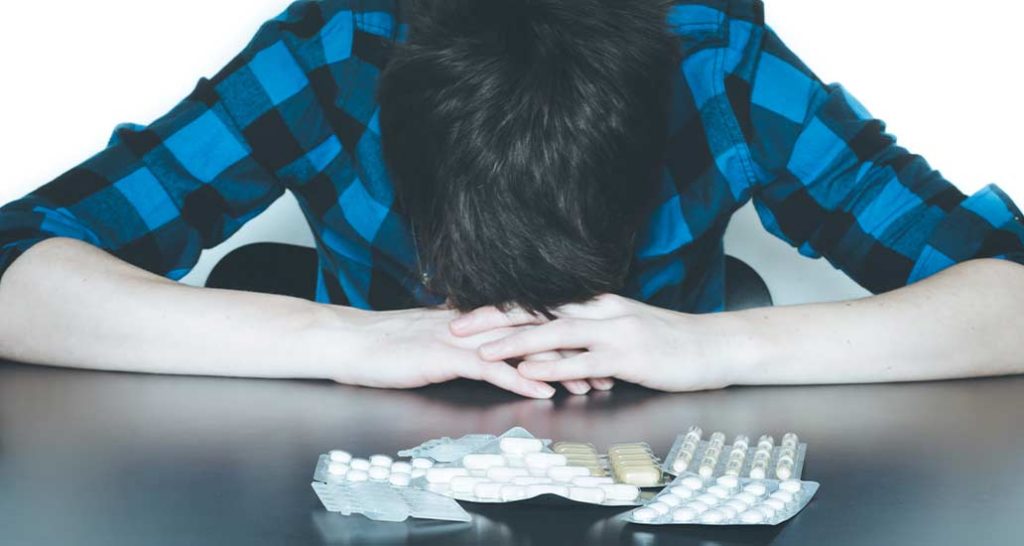As a society, our culture is shifting to destigmatize mental health issues and the use of medication. As a result, the use of some narcotic prescription drugs has become more common. Benzodiazepines are also known as Xanax, valium, and Klonopin are among some of the most prescribed medications today. They are used to treat conditions such as anxiety disorder, panic disorders, seizures, and insomnia.
While effective when used as prescribed, Benzodiazepines are also among the most abused prescription medications. In fact, they are a contributing factor in 30 percent of opioid overdoses.
In addition to the more common anti-anxiety meds and tranquilizers mentioned above, other benzodiazepines include:
- Chlordiazepoxide (Librium)
- Lorazepam (Ativan)
- Temazepam (Restoril)
As with all prescription medications, Benzodiazepines can be taken safely. However, high doses, overuse, and long-term ingestion, even when prescribed, can lead to benzodiazepine dependence and addiction. Dependence differs from addiction in several ways.
Someone can be physically or mentally dependent on a drug without being addicted. Physical dependence is characterized by a need to increase the dosage or frequency in order to obtain the same effects.
For example, a daily dose of Xanax may help to regulate the symptoms of anxiety for a period of time. After a period of time, the body builds a tolerance for that dose. Additional doses may be needed to continue the suppression of symptoms. The need to increase the quantity or frequency in which Benzodiazepines are used creates a higher probability of dependence.
While the body builds gradual tolerance for higher doses, the lethality of that dose does not change. This makes dependence especially dangerous. The body fails to react or create warning signs that dangerous levels of drugs have entered the bloodstream.
When someone is dependent on Benzodiazepines, they experience a biochemical change in their brain. These biochemical processes lead to physical symptoms like:
- An intense need or desire to use the drug
- Symptoms of anxiety, like nervousness or tightening of the stomach muscles
- An inability to sleep, eat, or function normally
When someone is addicted to drugs or alcohol, they may continue to use despite negative consequences. These consequences often include job loss, family disruption, health concerns, or legal issues. Regardless of these consequences, the craving for more of the substance is greater than the fear of further loss.
Addiction retrains the brain to prioritize substance use over other essential needs like food, water, and air. This creates an unhealthy obsession where some will go to any lengths necessary to obtain and use their chosen substance.
Whether dependent or addicted to a substance, the effects and dangers of benzo withdrawal are real and can be life-threatening.

Signs of Benzodiazepine Abuse
Because these medications are often prescribed by a doctor or psychiatrist many people continue taking sedatives like Benzodiazepines for years. It’s easy for these individuals to dispel ideas of addiction or dependence because they take their medication as prescribed. While outwardly symptoms of dependence may not be apparent, internally the body tells a different story.
As the prescribed individual continues taking Benzodiazepines, they may avoid the side effects of dependence. However, problems will become apparent once the medication is stopped whether by intention or accident.
The earliest symptoms of benzodiazepine abuse resemble the early stages of alcohol intoxication. Benzodiazepines produce physical and psychological symptoms like confusion, emotional numbness, depression, and impaired judgment ensue.
Users can also experience memory loss, impaired motor response, and extreme drowsiness. Long-term misuse also increases the risks of health problems. This includes liver or kidney damage, heart and gastrointestinal problems, and neurological problems.
When paired with another central nervous system depressant, such as alcohol or opiates, the effects of Benzodiazepines will be amplified. This effectively heightens the risk of death.
The combination of Benzodiazepines with alcohol or opiates creates levels of extreme intoxication. This commonly produces symptoms such as slurred speech, nausea, vomiting, drowsiness, muscle weakness and slow reaction time. Any of these symptoms alone would be cause for concern. When they are combined there occurs a risk of aspiration or choking to death due to depressed awareness and reaction abilities.
Another factor in the likelihood of an overdose occurs as a result of lowered inhibitions and awareness. These intoxicants shut down rational thought and may prevent an individual from stopping use before too much is ingested.
Signs of Benzodiazepine Overdose
Knowing the symptoms of an overdose can mean the difference between life and death. Seeking emergency help for a suspected overdose is the most effective way to avoid serious complications or fatalities. An overdose occurs when the levels of substances in the body build up faster than the body can eliminate the drug. What are the signs to look out for?
Symptoms of Benzo Overdose Include:
- Confusion
- Dizziness
- Blurred or double vision
- Lack of coordination
- Extreme drowsiness
- Slurred speech or incoherence
- Stomach upset
- Muscle tremor or weakness
- Slowed or stopped respiration
- Low blood pressure
- Slowed heart rate
- A bluish tint to fingernails and lips
In the event that one or more of these symptoms is present, please seek medical help immediately.
Suddenly stopping the use of benzos such as with Valium or Librium will typically produce symptoms of withdrawal within 24 hours. For shorter-acting medications like Xanax, that withdrawal onset time is reduced to 10 – 12 hours.
The side effects of benzo withdrawal can become both physically and emotionally painful. If detox is attempted without medical supervision, it could become deadly. It is important to find a comprehensive detox program operated and overseen by medical professionals. It is also important to confirm the facility in question has experience managing benzodiazepine withdrawal symptoms specifically.

Benzodiazepine Withdrawal Symptoms Phases
Benzo withdrawal symptoms can range from mild to severe depending on the length of use and typical dosage for that individual. Because benzo withdrawal can lead to death in severe cases, trying to quit cold turkey or unassisted is not recommended.
Early withdrawal: The earliest stages of withdrawal may seem tolerable. This phase usually includes mild to moderate symptoms of anxiety and insomnia or interrupted sleep patterns.
Acute withdrawal: Once the Benzodiazepines have left the body, the onset of acute withdrawal begins and with it brings new symptoms. Symptoms may include increased agitation, trouble concentrating, and anxiety. Without detox medications and medical supervision, this is also the phase in which many individuals experience withdrawal induced seizures.
This side effect is particularly dangerous especially when an individual is attempting to detox unassisted. They run the risk of injury from falling, tongue swallowing, or aspiration. Individuals in the acute phase of benzo withdrawal may become hyper-vigilant and paranoid. They may also experience problems like tremors, migraines, or muscle pain.
Additional symptoms include hands trembling, heart palpitations, and nausea or vomiting. In the most severe cases, psychosis or suicidal thoughts may occur.
Protracted withdrawal Protracted withdrawal refers more to the long-term effects of quitting benzo use. This includes severe mood swings, increased sleep problems, anxiety, and muscle twitches. If left untreated, and dependent upon the length and severity of use, these effects may continue for months or even years.
Managing Side-Effects and Withdrawal Symptoms
The risks of quitting Benzodiazepines without medical supervision range from mild discomfort to death. Experiencing physical and emotional distress along with the potential for death makes a strong case for a safe and effective detox.
Detoxing from benzodiazepines isn’t easy, but it can be accomplished with medical intervention in a safe place. The initial detox phase will be safer and more comfortable with inpatient care at a licensed facility.
The length of time it takes to complete the cycle of withdrawal and detox depends upon several factors including:
- Length of use
- Amount of drug ingested
- The mindset of the patient
- Type of drug used, as well as other substances used with Benzodiazepines
- Method of use, such as smoking, injecting, or snorting as opposed to taking pills
- Underlying health and mental health problems
- Detox and Rehabilitation
The medical detox process is designed to reduce the effects of benzodiazepine withdrawal. It also allows the body to completely eliminate the substance. Once clear of all traces of Benzodiazepines, usually within 48-72 hours, individuals will be reassessed for further treatment.
Medical detox will ensure that any pain or anxiety is addressed. Your treatment team will be involved in addressing any social and mental health issues that may arise during treatment. Once you’ve detoxed, we’ll work with you to establish an individualized treatment plan created to address your specific needs.
Depending on the length and severity of use, treatment options could include partial hospitalization, inpatient care, or intensive outpatient treatment. Almost all rehabilitation includes aftercare to help preserve and support long-term recovery.
Most healthcare plans cover at least some of the cost of treatment. Check with your healthcare provider to learn more about your individual coverage options and restrictions.
Ready to Get Help?
If you or a loved one need help with benzodiazepine addiction, we are here for you. Call 855-334-6120 to speak with an admissions coordinator.


 Can a Marriage Survive Drug Addiction?
Can a Marriage Survive Drug Addiction?